The epic European hiking trail hardly anyone knows about
Stretching 2000 kilometres from Slovenia to Albania, the Via Dinarica is the epic long-distance hiking trail almost no one has heard of. More accurately, it’s a network of paths that follows three main routes – one over the highest peaks of the Dinaric Alps (the White Trail), another that skirts the Adriatic coastline (Blue Trail) and a bike-friendly track that meanders through the range’s forested foothills (Green Trail).
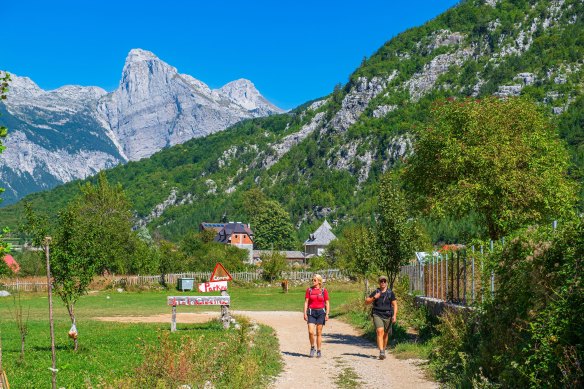
On the trail in Theth National Park, Albania.Credit: Alamy
Started in 2010, it’s an ambitious scheme that hopes to lure visitors to the region’s mountainous inland areas and also provide a healing cultural corridor through a series of countries that are still recovering from the brutal conflict of the 1990s Balkans war.
Theoretically, with enough time, resources, local contacts and Cyrillic language skills, you could tackle it yourself. Given I have none of these, instead I decide to join Intrepid Travel’s new 10-day Hiking the Balkans trip. Starting in Split on Croatia’s glittering Adriatic coast, it will showcase a selection of the Via Dinarica’s best hikes in Bosnia and Herzegovina, Montenegro and Albania.
Along the way, we’ll get to learn about the region’s history and culture, sample its specialty dishes, drink an unhealthy amount of rakia (a local grape brandy that’s akin to being hit by a cannonball) and experience some of the most spectacular hikes and vistas I’ve seen anywhere in the world.
Mountain highs
How to sum up six hikes over 10 days in three different countries? Let’s start with varied. Never before have I encountered such an astonishing diversity of terrain and panoramas on one trip.
Our first outing is a strenuous 21-kilometre trek to Outlaw’s Gate, a striking natural stone archway located almost 2000 metres up Cvrsnica Mountain in Bosnia and Herzegovina. In addition to our main guide, Bashkim Fazliu, we’ve been joined by Miroslav Mihalj, president of the local hiking group and a certified mountain rescuer – a fact that is both reassuring and slightly concerning (err … why exactly do we need a mountain rescuer?).
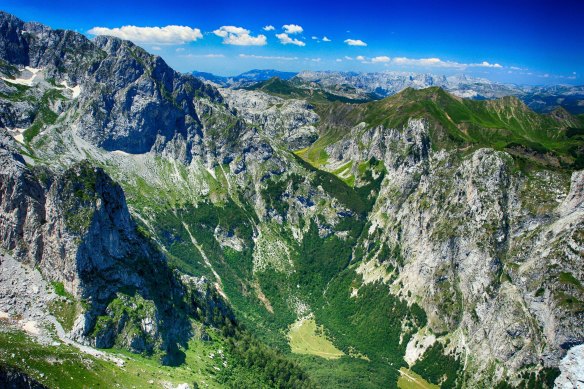
The Accursed Mountains on the border between Montenegro, Albania and Kosovo.Credit: Alamy
After a succession of wildflower-strewn valleys one of our 12-strong group bursts into a spontaneous rendition of Edelweiss, even as the terrain gets increasingly steep and rocky. Eventually, we reach the archway, a six-metre-high national monument named after a group of freedom fighters that battled the Ottoman Empire. After a hearty sausage and bean soup washed down with several shots of rakia in the country’s highest mountain hut, we make the 2.5-hour descent back down in darkness, a snaking procession of head torches under a vast, star-dusted sky.
It’s the first in a series of hikes that only get more impressive. The following day we feed apples and carrots to a herd of 200 wild horses that roam the windswept grass foothills of Cincar Mountain. The day after, we tackle an 18-kilometre loop around Bjelasnica Mountain near Sarajevo that skirts a plunging canyon en route to Lukomir, the country’s highest and most remote village. Located at 1500 metres, this huddle of tin-roofed shepherd huts is surrounded by medieval tombstones that date from the 12th century.
Montenegro receives worthy acclaim for its spectacular coastline, but more than two-thirds of the country is mountainous (its name literally means “black mountain”) and the Via Dinarica has helped to raise the profile of this lesser-known asset.
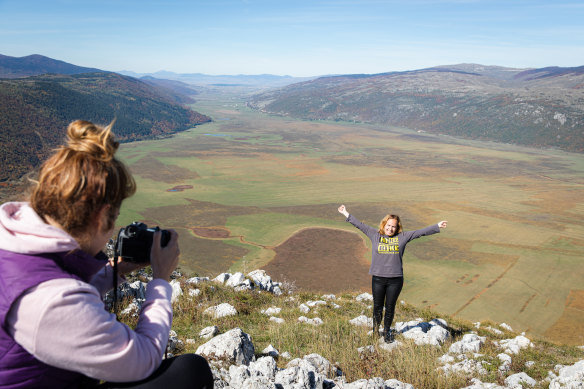
Valley views from a lookout at Cincar.
In the UNESCO World Heritage-listed Durmitor National Park, we visit several postcard-worthy emerald lakes before enjoying a sunset drink (rakia, naturally) on a vertiginous outcrop overlooking Tara Canyon, Europe’s biggest and deepest canyon.
After a three-hour drive to the tiny hamlet of Vusanje, we ascend into the Accursed Mountains and knock off a trio of 2000-metre summits that provide knockout views of the Karanfili peaks, a stunning Dolomites-like curtain of soaring snow-dusted granite spires. When we arrive at the first summit, a fellow hiker cries: “Stop! It’s breaking my eyeballs.”
Albania is a one-hike wonder, but it’s arguably the most spectacular of the trip – the 19-kilometre trek from Theth to Valbona, a challenging climb up and over a 1795-metre-high mountain pass that rewards weary walkers with yet more eyeball-breaking vistas of towering peaks and plunging forested ravines.
Intrepid rates this trip as four out of five, stating that a “moderate level of fitness is a must”. I’d suggest that should be upgraded to a “good level of fitness”. While none of the hikes requires technical climbing skills, some of the group struggle with the distances and the steep ascents. As Fazliu puts it one morning with typical Balkan candour: “Today you are going to suffer.”
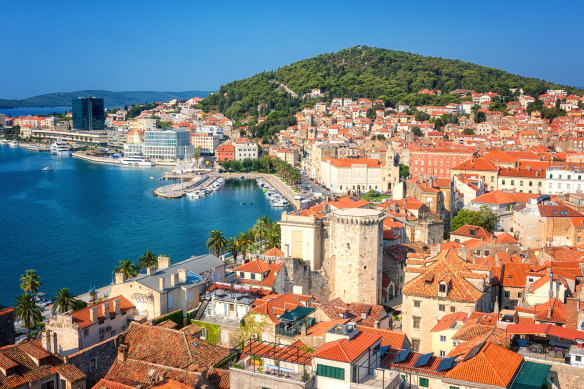
Split and its cityscape.Credit: iStock
Urban intrigue
While the hikes are the headline attraction, the trip is bookended by two of the region’s most intriguing cities. Split perpetually plays second fiddle to its more famous coastal sibling, Dubrovnik, yet it offers one of the world’s best-preserved Roman residences (the sprawling Diocletian’s Palace), an atmospheric Old Town and several delightful beaches.
By contrast, the Albanian capital of Tirana, where we finish the trip, is arguably Europe’s most rapidly changing metropolis. From 1946 to 1991, it was the headquarters of one of the world’s most isolated communist regimes, evidenced by the brutalist Soviet-style buildings that still surround the city’s yawning Skanderbeg Square. But since tossing off its communist shackles, it’s enjoying a period of explosive prosperity, the skyline filling with gleaming apartment blocks and swish five-star hotels. Albania is also one of the Balkans’ most religiously tolerant nations, a place where Muslims, Christians and Jews live side by side in relative harmony.
For many of us, the most affecting city we visit is Bosnia and Herzegovina’s capital, Sarajevo. Once described as the “Jerusalem of Europe”, a place where you can still find a mosque, a synagogue and a church within a few blocks of each other, it became a bloodbath of ethnic cleansing during the Balkans war, enduring a relentless four-year siege (the longest in the history of modern warfare). Today, it has bounced back and is once again one of the region’s most vibrant capitals, an intriguing mix of 16th-century Ottoman-era mosques and grand, pastel-coloured 19th-century edifices built by the Austro-Hungarian Empire.
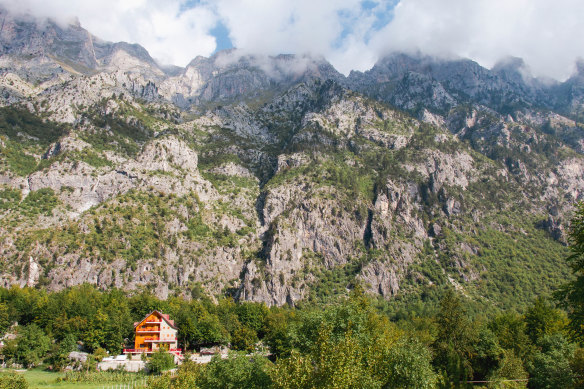
Remote shelter in the Valbona Valley.
Trying to get your head around the Balkans’ convoluted history is no easy task. Fazliu is a bottomless well of facts and opinions, but even he admits it’s a bewildering tangle of empires, religions and conflicts. After explaining Bosnia and Herzegovina’s present-day Constitution, a uniquely complicated administration comprising two autonomous entities and one jointly administered district, he concludes by saying: “If you don’t get it, don’t feel bad. It’s not you, it’s Bosnia.”
Regional fare
Sampling the local cuisine is one of travel’s perennial rewards, but it feels especially gratifying after a day of hiking. And given that the Balkans has a long history of feeding farmers, shepherds and soldiers, it’s no surprise that regional specialties are hearty, calorific affairs. Some are deliciously guilty pleasures, such as kajmak, a rich, clotted cream-like spread made from milk fat, and the ubiquitous burek, a filo pastry pie stuffed with minced meat, cheese, spinach or potato. Others are more challenging, like the breakfast dish of pura s lucinicom, a corn porridge served with a cold soup of sour cream, butter and garlic, and ustipci, a bland and greasy deep-fried fritter.
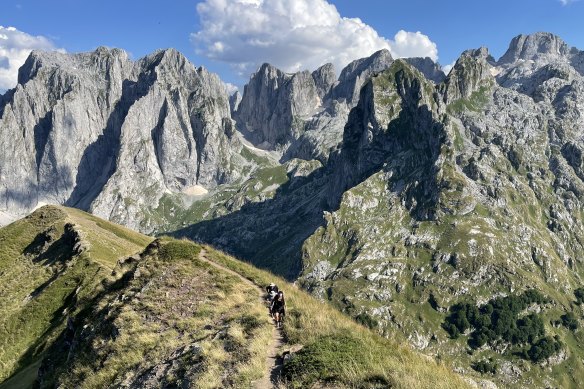
Hiking in the Accursed Mountains.Credit: Rob McFarland
Interestingly, the region is becoming increasingly well regarded for its wine, particularly blatina, a full-bodied red grown in the south of Bosnia and Herzegovina, and vranac, a rich, ruby-coloured drop from Montenegro.
And then, of course, there’s rakia, the heart-stopping 40 per cent (and sometimes stronger) fruit brandy that’s the region’s primary social lubricant. I lose track of the number of times it mysteriously appears before or after a meal, but a shot of it never fails to render me temporarily speechless.
A bright future
It’s rare you get to visit a region in the midst of such a pivotal period of change, but it’s clear that in 10 years the Balkans will look very different to today. Montenegro is tipped to be the next country admitted to the European Union with Albania, Serbia and Bosnia and Herzegovina hot on its heels. While this will bring much-needed economic and social benefits, hopefully it won’t change the region’s intriguing cultural identity. Because despite all the hardship and conflict, there’s still an underlying affection and respect. During the trip’s welcome meeting on day one, Fazliu, who lives in Croatia but was born in Kosovo to Albanian parents, proudly declares: “I love my crazy, weird Balkan family.”
THE DETAILS
Intrepid Travel’s 10-day Hiking the Balkans trip from Split to Tirana runs from June to September and includes accommodation, six guided hikes and some meals. Maximum group size is 12. From $4060 a person, twin share. See intrepidtravel.com
The writer was a guest of Intrepid Travel.
Sign up for the Traveller Deals newsletter
Get exclusive travel deals delivered straight to your inbox. Sign up now.